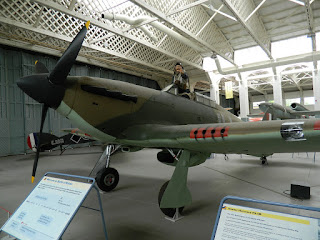Hawker Hurricane MK II B The main British fighter in Battle of Britain, 32 squadrons were equipped with Hurricanes, comparing to 19 equipped with Spitfires. Hurricane Mk I was first monoplane, single seat fighter that entered RAF service in 1937. It was slower than German Me 109,but very effective against bombers (armed with 8 guns). Hurricane was used as a fighter, fighter-bomber, also for ground attack, convoy defense and in other support roles. Two Hurricane squadrons operated from Duxford airfield - No 242 and Czechoslovakian No 310. Thais aircraft was recovered from crash site in Russia, Mk II did not enter the service until 1941, but was painted to represent MKII A of No 111 Squadron in 1940.
Rolls Royce Merlin Engine
V1 Flying Bomb with Launch Station, fired against Britain in 1944 - 1945 as reprisal weapon for bombing German cities. Mostly fired from steam driven ramps and then self propelled by an Argus pulse-jet motor. Pre-set controls guided V1 to it's target where it was to explode causing widespread damage. Despite vast numbers being launched, killing thousands, many V1's were destroyed before reaching targets by AA guns or fighter, did not alter the course of war.
Spitfire Replica
Messerchmitt 109 E the most famous German fighter in Second World War. This one took part in Battle of Britain with JG 26 fighter unit, scoring 5 victories before engine failure on 30 September 1940. Crash landed near East Dean, Sussex. Pilot was shot & captured after landing.
Anderson air raid shelter, the most widely used domestic air raid shelter during the Blitz. Design developed in late 1938, named after the Minister of Air Raid Precautions (ARP). The Shelter was made out of corrugated steel sheets bolted together in a pit 3ft to 4ft deep and covered in earth. Could withstand almost any bomb blast except direct hit. Around 2 300 000 were distributed by September 1940.
ARP warden's shelter
Hawker Hurricane Mk XII A
Spitfire MK VB































































No comments:
Post a Comment